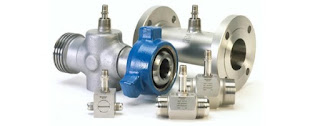Pneumatic valve actuators come in three basic design varieties:
- Scotch-yoke
- Rack & pinion
- Rotary vane
All three types provide the same function - converting air pressure to rotational movement intended to open, close, or position a quarter-turn valve (ball valves, plug valves, butterfly valves, or other 90 degree rotational valves).
All three styles are available in either direct acting or spring return versions. Direct acting actuators use the air supply to move the actuator in both directions (open and close). Spring return actuators, as the name implies, uses springs to move the actuator back to its "resting" state. Converting from direct acting to spring return is done through simple modifications, typically just adding an external spring module, or removing the end caps from rack and pinion actuators and installing several coil springs.
Scotch-yoke actuators use a pneumatic piston mechanism to transfer movement to a linear push rod, that in turn engages a pivoting lever arm to provide rotation. They come in a wide variety of sizes, but are very often used on larger valves because they are capable of producing very high torque output. Spring return units have a large return spring module mounted on the opposite end of the piston mechanism working directly against the pressurized cylinder.
A
rack & pinion pneumatic actuator uses opposing pistons with integral gears to engage a pinion gear shaft to produce rotation. Rack & pinion actuators (sometimes referred to as a lunch box because of their shape) tend to be more compact than scotch yoke, have standardized mounting patterns, and produce output torques suitable for small to medium sized valves. They almost always include standard bolting and coupling patterns to directly attach a valve, solenoid, limit switch or positioner. Rack and pinion actuators use several smaller coil springs mounted internally and provide the torque to return the valve to its starting position.
Vane actuators generally provide the most space savings when comparing size-to-torque with rack and pinion and scotch yoke. They have a reputation for long life because then contain fewer moving parts than rack and pinion and scotch yoke actuators. Vane actuators use externally mounted, helically wound "clock springs" for their spring return mechanism.
The practical difference between these three types of pneumatic actuators comes down to size, power, torque curve and ease of adding peripherals. For the best selection of valve actuator for any quarter turn valve application, you should
seek the advice of a qualified valve automation specialist. By doing so your valve actuation package will be optimized for safety, longevity, and performance.






